
Venereal Disease Treatment Menu: 1 2 3 4 5 6 7 8 9 10 11 12 13 14 Next>>
Venereal Diseases in the Golden Age of Piracy, Page 13
Treating VD During the GAoP: Second Stage (Confirmed Pox) - Cure By Salivation
Salivation was the final method recommended for curing a Confirmed Pox in combination with purges or sweating. It had the widest support among the sea surgeons; John Moyle and John Atkins both explained the salivation procedure and John Woodall recommended mercury-based medicines to be used to salivate a pox.
Salivation was tied directly to the use of mercury. Atkins explained that "Mercury, i. e. the Preparations in use, ordinarily operates by a Flux [flow] through the Salival Glands, and by the Parvity [small size] of its
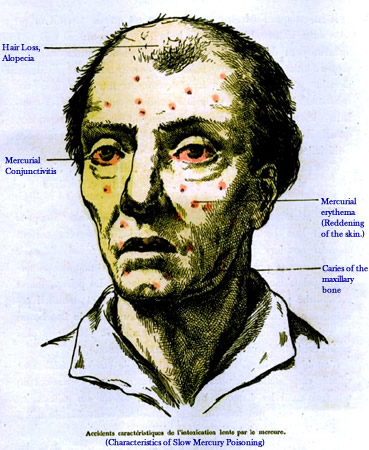
External Symptoms of Slow Mercury Poisoning, From
Les Grands Maux
et les Grands Remedes, By Jule Rengade, p. 673 (1879)
compounding Parts has a peculiar Aptitude thereto"1. Over time and with the continuous use of mercury, Atkins felt that the patient's blood could "separate its noxious and incongruous Parts [referring to the venereal poisons it contained], which are daily washed and spewed out by the thin Liquors continually taken"2. More of the esoteric theory behind the usefulness of mercury in treating venereal diseases can be found in the section on mercury-based medicines.
While Atkins recommended the use of mercury, he also understood that it was a dangerous medicine, particularly for "Aged People, with such as are lean, or dejected thro' Trouble or Misfortunes, or much emaciated; but especially with those whose Lungs are any way distemper'd... because, as this Habit is acquired by the Glandulous Secretions being increas'd, Mercury pejorates [makes worse] the Mischief"3. Atkins lists some complications resulting from its use including bleeding from the mouth, excessive sweating, harm to the lungs and potential death4, but he does not go so far as to rule it out as a treatment for a Confirmed Pox.
English physician John Sintelaer presents a much more comprehensive list of complications that can result from the use of mercury, arguing for its complete ban when treating patients with venereal diseases. His comprehensive list of the side effects of mercury observed in the workers who mine it include "Tremblings, Palsies, Convulsions, Lethargies, Asthma's and Apoplexies [unconsciousness, with loss of sense and motion]" as well as eventual death.5 By way of comparison, the US Environmental Protection Agency's list of symptoms of elemental mercury poisoning includes tremors, weakness, muscle atrophy, twitching,
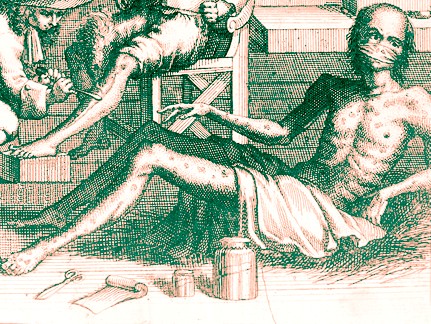
Mercury Poisoning/Syphilis Victim, From
The Scourge of Venus and Mercury,
By John Sintelaer, frontispiece (1709)
headaches, emotional changes, changes in nerve responses, and poor mental performance, among other things.6 Ingesting mercury compounds can produce skin rashes, mood swings, gastrointestinal damage and muscle weakness.
Nevertheless, salivation by mercury remained a popular cure - if not the most popular cure - for a Confirmed Pox from its recognition in the late 15th century, during the golden age of piracy and well beyond. Contrary to Sintelaer's protests, German surgeon Matthias Gottfried Purmann explained that mercury "is the only Medicine that can be depended on, in order to a successful Cure: Let some Men rail against it as long as they please, they do but discover their own Ignorance and want of Experience; for when all is done, nothing but Mercury is absolute Conqueror of this Disease."8
With regard to salivation treatment, two different types of applications could be used: internal (using oral medicines) and topical (using topical pastes). To prepare the patient for either type of mercury application, Atkins stated that "Two or three Purges always precede as preparative"9.
Sea surgeon John Moyle notes that when "Purging and Sweating will not do, but that he must be Fluxed; then an Hospital, or House on shore is fitter for him, then that either you, or the Ship, should be troubled with him."10 Moyle's protest seems to center on the difficulty of salivating on a ship since he goes on to say that he will explain the process of salivation for those sea surgeons who are able to "make conveniency for him". This suggests that salivation would not be performed aboard a ship most of the time. Atkins similarly suggests that care for patients with venereal diseases on ships was poor leading to prolonged salivation11, but he never suggests it was too troublesome to be used.
1,2 John Atkins, The Navy Surgeon, 1742, p. 241; 3 John Atkins, Lues Venerea, p. 37; 4 Atkins, Navy Surgeon, p. 240; 5 John Sintelaer, The Scourge of Venus and Mercury, 1709, p. 164; 6 "Health Effects of Exposures to Mercury: Elemental (Metallic) Mercury Effects:", www.epa.gov, gathered 6/9/18; 7 "Health Effects of Exposures to Mercury: Effects of Other Mercury Compounds:", www.epa.gov, gathered 6/10/18; 8 Matthias Gottfried Purmann, Churgia Curiosa, 1706, p. 194; 9 Atkins, Navy Surgeon, p. 241 & Lues Venerea, p. 38; 10 John Moyle, Chirugius Marinus: Or, The Sea Chirurgeon, 1693, p. 146; 11 Atkins, Navy Surgeon, p. 246
Salivating a Confirmed Pox - External Application of Mercury (Unction)
For external applications, mercury was kneaded into different paste-like substances and applied to the body once the patient had been purged. Some of these pastes were quite simple. Sea surgeon John Atkins recommends using four ounces of crude liquid mercury mixed with 12 ounces of pork lard in both of his books.1 Others were not so simple. Sea surgeon John Moyle suggests using Neapolitan Unguent2, the recipe for which is:

Artist: Rudolf Ernst
Making Essential Oils, "The Perfume Makers (19th-20th c.)
Take Hog's Lard wash'd with the Juice of Sage {1 pound} Quicksilver strained thro' Leather {4 ounces} Oil of Bays, [oil of] Camomile, and [oil of] Earthworms, {of each 2 ounces}. Oil of Spike [oil of spike lavender] {1.5 ounces} Spirit V[ini]. {1 ounce} yellow Wax {2 ounces} Turpentine washed in the juice of Elicampane {3 ounces} Powder of Chamepitys [the plant ajuga chamaepitys] and Sage, {of each 2 ounces} Mix together S.A. [and make according to art].5
Many of the various oils as well as sage included in this mixture have soothing properties, likely to reduce the pain caused by slathering the patient with mercury. Although this unguent is complicated, Moyle probably bought it pre-made given the inclusion of several unusual ingredients in this compound medicine which were not typically found in the sea surgeon's medicine chest.
In one of his case studies, Moyle suggests a different prescription for unction: "Rx Argent. Viv[um]. [mercury] in Tereb. extinct. [turpentine containing amber] {4 ounces} Axung. Porc. [pork lard] {8 drams}. Ung[uen]t. Nervin[ium]. [nerve ointment] {6 ounces} Misce. exquisite. [mix well] f. Unguent. [made into an unguent]"4. However, this concoction failed to work, so Moyle switched methods, employing an internal medicine instead: "Turb. Min. [turbith minerale, a compound medicine containing mercury & oil of vitriol] {12 grains} In Cons[erve]. Borrag[e]. [believed the strengthen the patient] {1 dram} and a draught of warm Possit Ale"5.
Physician Matthias Gottfried Purmann starts his external medicine by combining mercury with clear turpentine. He explains that the reader is to
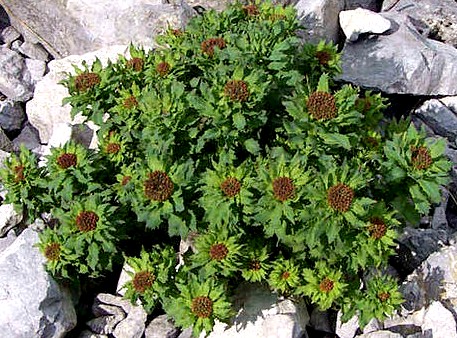
Photo: Opiola Jerzy - Rhodiola Rosea Plant
Strain the Mercury through Leather, and then incorporate it with the Turpentine in a Stone Mortar, till they are perfectly united, to which add the following Ingredients.
Axung. Porcin. [pork lard] {1.5 ounces} Unguent. Nervin[ium]. {1 ounce} Ol Lign[um]. Rhod[ium]. [An oil made from the rhodiola rosea, a plant believed to strengthen the patient] {15 drops} Misce exactissim. ad Unquent. s.a. [mix exactly into an unquent according to art]6
Purmann recommended that the surgeon "anoint the joints of the Hands and Feet, Morning and Evening" the day after purging the patient. Purmann went on noting that the application was "an Ounce or two at a time, and remember to cover the Joints with Paper or Linnen Rags. The second day, if the Patient is very much infected, you may anoint the Joints of his Arms and Knees again, Morning and Evening as before. The like you may do the third day, and if he does not begin to Spit, repeat it the forth day, and then it will operate."7
With regard to medicine quantity, Atkins similarly recommended an ounce each day,

Applying Mercury Paste, From The Scourge of Venus and Mercury,
By John Sintelaer, frontispiece (1709)
for three Days successively, beginning, the first Illiniation on the Wrists and Ancles only, leaving the Patient to chase [rub] it in with his Hands warm’d before the Fire; the second higher, around the Joints of the Knees and Elbows; and the third yet further up, but cautiously, because the nearer you anoint to the Abdomen, the more likely the Body will be of being laxative, and eludes its proper Operation8
Atkins notes that there is variability in how much mercury paste is required to effectively raise a salivation. He notes that sometimes 1.5 ounces will do the job "and at other Time[s] {1/2 pound} [is] ineffectual. The latter was my common way with Sailors, whom I have frequently salivated on the Ollop [orlop deck]."9
If the topical treatments failed to raise a salivation, Atkins suggested repeating the applications along with having the patient drink a Turbith-based medicine similar to that mentioned by Moyle in his case study. Purmann likewise recommends an oral dose if unction doesn't work within four or five days, using either "Mercurium [sublimate] dulcis {15 grains} or ...4 or 5 grains of Terbith Minerale, which soon procures a Flux."10
Moyle advised his reader to "anoint the soles of the Feet, the Legs, and the Thighs, (you seldom need to go higher) but anoint not the Belly; now this anointing once a day, will at a few times raise the Salivation."11 He doesn't mention the quantity to be used. Atkins likewise warns that "the nearer you anoint to the Abdomen, the more likely the Body will be of being Laxative, and elude its proper Operation"12 in his book Lues Venerea.
In a case study found in his Memoirs, Moyle chose to apply the mercury paste more extensively, starting in the morning "at the Soles of the Feet, and so up the Legs, Thighs and Hips, also the Spina Dorsi, Shoulders, Arms and Hands, but not Head, Breast nor Belly"13. He repeated the application in the evening and then again in the morning and evening of the next day. Because it still failed to produce salivation, he administered a dose of the turbith medicine.
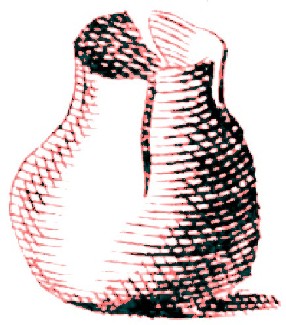
A Pig's Bladder, From Cours d'Operations de Chirurgerie,
By Pierre Dionis, p. 500 (1708)
When applying Mercury, Moyle recommended using "thin vessicæ Porcinæ on your hands to defend them"14, referring to the urinary bladders of pigs. Purmann avoids having to handle the mercury paste at all, advising "let the Patient rub himself very well near a Fire"15. In his case study, Moyle mentions that having the patient apply the paste to himself was a good idea, although "because I would have it well done, I did it my self."16 Atkins doesn't mention how he chooses to get the paste applied to the patient, although he does note that once it is applied, the surgeon should "draw on a Pair of Gloves and Stockings [on the patient] after Use of it, to keep the Linnen and Bedcloaths clean."17
Moyle explains that once salivation starts, the surgeon should cease to apply the mercury paste.18 Purmann likewise recommends "you must diligently watch your Patient’s Mouth, to see when the Flux begins to rise"19. Atkins closes his description of the salivation by unction with a comment on the procedure itself. "This Way by Unction I prefer, especially in weak Bodies; the other [method - using oral medication] more certainly causing Nausea, Vomiting, Looseness, Faintness, and the like Accidents, that interrupt a regular Course of Proceeding, and give great Uneasiness to the Patient"20. This is actually an interesting comment on the symptoms of ingested mercury poisoning.
1 John Atkins, The Navy Surgeon, 1742, p. 241 & Lues Venerea, p. 38; 2 John Moyle, Chirugius Marinus: Or, The Sea Chirurgeon, 1693, p. 148; 3 John Quincy, Pharmacopoeia Officinalis & Extemporanea, 1719, p. 456; 4 John Moyle, Memoirs: Of many Extraordinary Cures, 1708, p. 87; 5 Moyle, Memoirs, p. 88; 6 Matthias Gottfried Purmann, Churgia Curiosa, 1706, p. 194; 7 Purmann, p. 194-5; 8 Atkins, Navy Surgeon, p. 241; 9 Atkins, Navy Surgeon, p. 243; 10 Purmann, p. 195; 11 Moyle, Chirugius Marinus, p. 241; 12 Atkins, Lues Venerea, p. 38; 13 Moyle, Memoirs, p. 87; 14 Moyle, Chirugius Marinus, p. 148; 15 Purmann, p. 195; 16 Moyle, Memoirs, p. 87; 17 Atkins, Navy Surgeon, p. 241; 18 Moyle, Chirugius Marinus, p. 149; 19 Purmann, p. 195; 20 Atkins, Lues Venerea, p. 39
Salivating a Confirmed Pox - Internal (Oral) Medicines
Sea surgeon John Atkins begins his discussion on the use of the oral medicines used to cause salivation by explaining that "Unction has also its Faults, and is Offensive by its Smell and nastying the Cloths; since many also differ from me in this Preference,
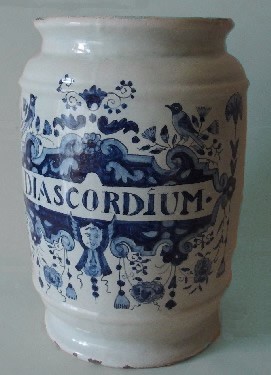
Delft-Style Disascordium Electuary Drug Jar
and give it to Mercurials, internally administred"1. However, he also notes that using internal medicines require more attention by the surgeon than applying mercury-based pastes. The other sea surgeon to discuss this method, John Moyle, doesn't suggest which method was better.
The oral medicines used by sea surgeons Atkins and Moyle to cause a salivation were mercury-based. Moyle says "the most usual is that of Turbith. mineralis [turbith minerale or yellow precipitate, a compound medicine containing mercury & oil of vitriol], in a Bolus of Conserve of Roses, or sometimes Diascordium; the Body being first well prepared"2. The conserve was probably included to improve the taste and for its ability to strengthen the patient, the diascordium electuary is a purge. The 'preparation of the body' refers to the use of purges to 'open' it.
Atkins recommends starting out with: "Rx. Mer[cury]. Dul[cis]. {10 grains} Laud[anum]. L[ondon]. {2 grains} Cons[erve]. Ros[es]. q. s. [a sufficient quantity] fiat Bolus [make into a bolus] quaque nocte sumend [taken every night]."3 Both the sweet mercury and laudanum are included for their ability to stimulate salivation. They were perceived as operating more 'gently' than some of the other salivating medicines. However, Atkins also says that if such 'softer' medicines fail to work, the surgeon should switch to the harsher turbith minerale.
Both sea surgeons suggest starting the oral medicines in lower doses, gradually increasing the amount of the active ingredients to procure a salivation. Moyle says, "I usually begin with {7 grains} [of salivating medicine] and the day following {9 grains} and then commonly the Flux riseth, and there is no need of more"4. Atkins begins with 10 grains of mercury sublimate dulcis and 2 grains of laudanum as noted above. Once that first dose is given, it should

Giving Oral Medication for Confirmed Pox, From Medicijn
Tegen Syfilis, By Philips Galle (c. 1589-93)
be increased two or three Grains every Repetition; because large Doses of it in the beginning exert too much force in the Primae viae [digestive system], and by the effect of their own Irritation, are pass'd off with their Contents [via excretion]; whereas a small one, without giving such disturbance, leisurely intrudes it self, and in the Circulation arrives at and wounds the Salival Glands; and when once it has obtain'd that Path, the subsequent Doses more easily follow, and suppress all Fears of a Diversion [by diarrhea].5
Atkins elsewhere explains that the surgeon "may go on with the Mercurial Bolus's for three or four Nights successively"6. If this fails to raise a sufficient salivation, the surgeon should use 5 to 8 grains of turpethium minerale. This is to be administered two or three nights in succession, with the dosage being increased a grain each time. Atkins explains that "Constitutions differ, and will... always and [there will be an] Exception to any stated Number, I’ve known two Bolus's of Calomel raise a Salivation, and other times Twenty fail."7
Our sea doctors made a few other observations about oral salivation which are of interest. Moyle noted that "if you see the Mouth and Jawes [of the patient] swell (although he doth not yet spit) then give no more [medicine], for he will salivate in a little time (but be sure your Turbith. is well prepared.)"8 Atkins warned that when a doctor is first starting to raise a salivation in a patient, "the only Thing to be feared and guarded against, is a Diarrhœa, which diverts the Operation of the Mercury from the salival Glands: This we must take notice is prevented, or abates and goes off"9. Although he doesn't give specific ideas on what to do to divert a diarrhea there, he does say that it is important for the surgeon to observe proper "Manner and Method, as well as in the Administrations themselves, and in a good ordering the Patient as to Diet and Confinement."10
1 John Atkins, Lues Venerea, not dated, p. 39; 2 John Moyle, Chirugius Marinus: Or, The Sea Chirurgeon, 1693, p. 149; 3 Atkins, Lues Venerea, p. 40; 4 Moyle, p. 149; 5 Atkins, Lues Venerea, p. 40; 6,7 John Atkins, The Navy Surgeon, 1742, p. 243; 8 Moyle, p. 149; 9,10 John Atkins, The Navy Surgeon, 1742, p. 242
Salivating a Confirmed Pox - Keeping the Patient Warm
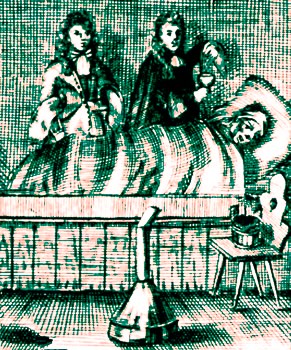
Keeping a Salivating Patient Warm, From Die Belagert u
Entfente Venus, By Stephen Blankaart (1689)
An important part of salivation was keeping the patient warm while undergoing the treatment. Matthias Gottfried Purmann explains, "The Chamber where the Patient is kept, must be close and tolerably warm, that no cold or sharp Air may injure him"1.
Sea surgeon John Atkins adds, "The Patient must be altogether confin'd to the Bed; he must be kept between the Blankets; the Bed well lin'd; the Room close and warm, and [given] a Julap pro Languoribus [a julap for illness]; the Head and Jaws should be covered also with Flannel, it repels the Effects of Cold, and is Anodyne [helps kill the pain]."2 He elsewhere explains that guarding against the cold 'is conducive' to a salivation. This is beneficial "by constipating the Pores, [and will] make the Body loose. Cutis densitas, alvi laxitas. [Pores tight, stomach loose.]"3
Moyle's advice on keeping the patient warm was explored in the section on sweating the patient. However, it is in line with Atkins' and Purmann's comments. To briefly review, Moyle recommends having "ready Flannel Stockins, Drawers, Shirt and Wastcoat, as likewise Flannel Muffler and Cap, for the body must be kept exceeding warm, (which soever way you Salivate.) Then the Patient must be laid in Flannel Sheets, and covered well, the Room or Cabbin must be hung about with warm hangings, that no cold come in"4. Moyle specifically connects keeping the patient warm with a sweating/salivation combination.
1 Matthias Gottfried Purmann, Churgia Curiosa, 1706, p. 195; 2 John Atkins, Lues Venerea, not dated, p. 43-4; 3 John Moyle, Chirugius Marinus: Or, The Sea Chirurgeon, 1693, p. 143; 4 John Moyle, Chirugius Marinus: Or, The Sea Chirurgeon, 1693, p. 148
Salivating a Confirmed Pox - Quantity and Quality of Salivation
Once the patient begins to salivate, Moyle says, "you must have a Spitting-Pot, and dry Napkins; for most Patients will spit at least a quart, and others three pints a day, or more; I have known some run at least two quarts."1 Examples of a spitting pot can be seen in the images found here and in the image seen in previous section.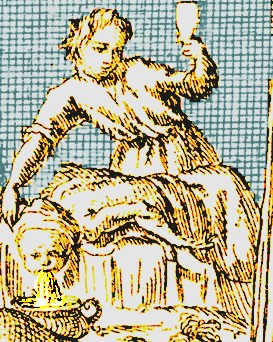
Collecting Saliva in Spitting Pot, From Martyrdom
of Mercury, By John Sintelaer, (1709)
In a case study, Moyle explains his patient had "a Spitting Pot, so that it was known what quantity he Salivated in the Day and Night, which was three Pints a Day at first, and at last two Quarts, to which stent I held him, for when it grew Languid [slowed], through Cold accidentally taken, he had a warm Enema Injected, which caused him to Spit the better, or if a Looseness happened, he had Diacordium [syrup of poppies], or Laudanum given to stop it."2 Moyle continued this patient's salivation for twenty-one days, after which it eased off, finally ceasing four days later.3
Sea surgeon John Atkins says that a salivation is working well when the patient is "spitting about a Quart in twenty-four Hours, till its Height and Return to that Quantity again, which may include a Fortnight, or more; and during this, the exactest Regulation is required to promote the Flux [flow of saliva], and avoid the Danger of a Diversion."4 Here again, 'Diversion' refers to diarrhea, which represented an unwanted flow of fluids caused by mercury. He adds, "I account the Salivation well raised, if I can make it amount to about two Quarts in a Natural Day, and continue it so for eight or ten; but let the highest Quantity be what it will, whenever it lessens regularly, it signifies the Mercury to have spent its utmost Force and Power"5.
Atkins also briefly mentions monitoring the quality of the salivation. “The Spittle, at first is thick and clammy; but as it increases in Quantity, grows thin and serous."6 He doesn't explain which is better, although the implication is that the 'thin and serous' saliva would be preferred. Moyle provides a little different measure of the quality of saliva, noting "you will best know when the Patient is Fluxed enough, by the Spittle growing sweet; for when the Patient salivates, it smells intolerably."7
1 John Moyle, Chirugius Marinus: Or, The Sea Chirurgeon, 1693, p. 150; 2 John Moyle, Memoirs: Of many Extraordinary Cures, 1708, p. 88; 3 Moyle, Memoirs, p. 89; 4,5 John Atkins, The Navy Surgeon, 1742, p. 244; 6 Atkins, Lues Venerea, p. 44; 7 Moyle, Chirugius Marinus, p. 151
Salivating a Confirmed Pox - Diet
Moyle recommends that while the salivation medicine is working, the patient should "drink extraordinary of the warm Posset drink, or thin Grewel, the more the better, and the like when he takes the checking Catharticks [purging medicines]."1
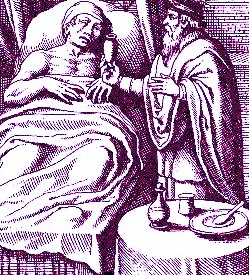
Administration de Efficaci Medicina Libri Tres,
by Marco Aurelio Severino, Title page (1646)
He advises continuing this all during the salivation, drinking "as much Grewel or Posset-drink as he can; for that is all, or most, that he has to live on during that time; which never is less than seventeen dayes, from the day first find him to begin to salivate; (not from the day he took the first Bolus) some continue it twenty one dayes, and some twenty seven dayes"2. In a case study in his Memoirs, Moyle is a little less rigorous in the proscribed diet, stating that the patient "might take Sustinance, which was of a Fowl and its Broth."3
German surgeon Matthias Gottfried Purmann recommends that the patient's "Drink must be a good Decoction of Lign. Guiac. [guaiac wood] &c. and his Food of easie Digestion. The Flux going on well, take care you do nothing to check it"4. Purmann's drink is a sudorific, suggesting that he would have the patient both sweat and salivate at the same time.
Sea surgeon John Atkins is the most generous in giving details about the patient's diet during salivation. He says it "should be dry and astringent; Rice, toasted Cheese, Yolks of Eggs in mull’d White-Wine, a Harts-Horn Drink, and Roast-Meats in general, are proper Food; minding to continue the most nourishing of them, (the Meats) as long as we an to support the Strength through; for in the Progress, the Throat will be too sore to beat swallowing any Thing but Liquids."5 He goes on to point out that once the throat does become sore, it "will admit of nothing but soft Liquors, as thin Broths and Gruels; which, as they afford very little Nourishment"6.
1 John Moyle, Chirugius Marinus: Or, The Sea Chirurgeon, 1693, p. 150; 3 Moyle, Chirugius Marinus, p. 151; 3 John Moyle, Memoirs: Of many Extraordinary Cures, 1708, p. 87; 4 Matthias Gottfried Purmann, Churgia Curiosa, 1706, p. 195; 5 John Atkins, The Navy Surgeon, 1742, p. 243-4; 6 Atkins, Navy Surgeon, p. 244

